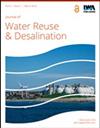Seasonal variations of pollutants removal and microbial activity in integrated constructed wetland–microbial fuel cell systems
IF 2.3
Q2 Environmental Science
引用次数: 8
Abstract
This study investigated the seasonal variations of pollutants removal and microbial activity in constructed wetland–microbial fuel cell systems (CW–MFCs). The results showed that the atmospheric temperature significantly influenced the bioelectricity generation and removal of organics and nitrogen in CW–MFCs by primarily influencing the microbial enzymatic activity. The electricity output of CW-MFCs was extremely low below 5 °C, and reached the maximum above 25 °C. The organics and nitrogen removal of closed-circuit CW–MFC reached the highest in summer and autumn, followed by spring, and decreased by an average of 10.5% COD, 14.2% NH3-N and 10.7% TN in winter, demonstrating smaller seasonal fluctuations compared to open-circuit CW–MFC in which the difference between summer and winter was 13.4% COD, 15.1% NH3-N and 15.1% TN. Even at low temperatures, the MFC current could enhance the enzymatic activity and stabilize the growth of microorganisms on the electrodes, moreover, the closed circuit operation can promote the bacteria diversity on CW–MFC anodes as well as the abundance of electrogens on CW–MFC anodes and cathodes, and thus reduce the adverse effect of cooling on organics and nitrogen removal in CWs. However, neither MFC nor temperature had a significant influence on phosphorus removal in CW–MFCs.人工湿地-微生物燃料电池系统中污染物去除和微生物活性的季节性变化
研究了人工湿地-微生物燃料电池系统(cw - mfc)中污染物去除和微生物活性的季节变化。结果表明,大气温度主要通过影响微生物酶活性来显著影响cw - mfc生物发电和有机物、氮的去除。cw - mfc的输出功率在5℃以下极低,在25℃以上达到最大值。闭路CW-MFC的有机物和氮去除率在夏季和秋季最高,春季次之,冬季COD平均下降10.5%,NH3-N平均下降14.2%,TN平均下降10.7%,与开路CW-MFC的夏季和冬季差异13.4%,NH3-N平均下降15.1%,TN平均下降15.1%相比,季节波动较小。MFC电流可以增强酶活性,稳定电极上微生物的生长,并且闭环操作可以促进CW-MFC阳极上细菌的多样性以及w - MFC阳极和阴极上电的丰度,从而减少冷却对cw中有机物和氮去除的不利影响。而MFC和温度对cw - MFC除磷均无显著影响。
本文章由计算机程序翻译,如有差异,请以英文原文为准。
求助全文
约1分钟内获得全文
求助全文
来源期刊

Journal of Water Reuse and Desalination
ENGINEERING, ENVIRONMENTAL-WATER RESOURCES
CiteScore
4.30
自引率
0.00%
发文量
23
审稿时长
16 weeks
期刊介绍:
Journal of Water Reuse and Desalination publishes refereed review articles, theoretical and experimental research papers, new findings and issues of unplanned and planned reuse. The journal welcomes contributions from developing and developed countries.
 求助内容:
求助内容: 应助结果提醒方式:
应助结果提醒方式:


